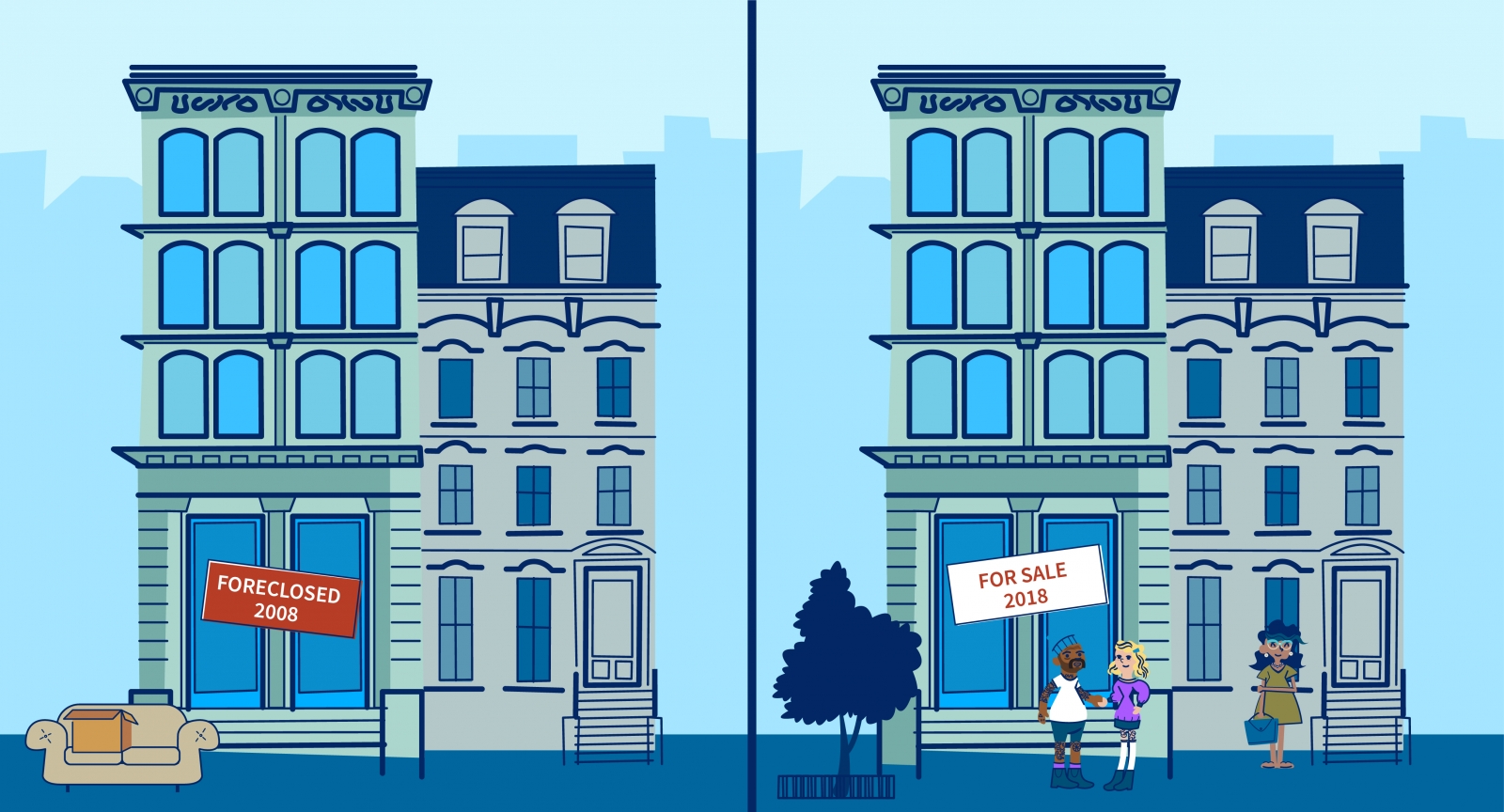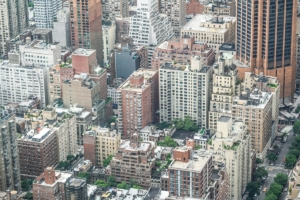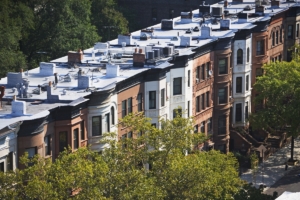
A decade after the 2008 financial crisis, NYC has bounced back. But the myth that real estate is always a smart investment has returned, too.
The global financial crisis culminated 10 years ago this month, as the Lehman Brothers investment bank filed for bankruptcy and the Federal Reserve moved to bail out the troubled insurance giant AIG. The crisis led to the deepest recession since the Great Depression, and it had many causes, including lax lending standards and a complex system of financial engineering that obscured risk. The crash forced a number of substantive changes in lending practices, government regulation, and investors’ approach to complicated financial instruments. But for all the lessons learned, one factor in the housing crisis remains stubbornly entrenched in the popular consciousness: The belief that real estate is an infallibly excellent investment.
As a center for global finance and real estate investing, New York was struck particularly hard by the crisis, leaving some fearing a return to the city’s 1970s lows. Instead, over the last decade, the local housing market has bounced back, with economic growth outpacing the national average and home values reaching record highs. The robust recovery — and the glass, metal, and stone luxury residential towers that accompanied it — have resurrected a longstanding belief that buying a home as soon as possible is the best way to secure one’s future in the growing city. In 2007, the economist Robert Shiller, who is noted for his work on financial bubbles, described a popular narrative that “warns people that they have to join the capitalist world and buy their homestead now, before it is priced out of reach by hordes of wealthy new investors.”
But despite the city’s strong recovery, not everyone who invested in New York city real estate in the last 10 years has come out far ahead. There are plenty of cautionary tales from the past decade, and even more as we look to the future:
- The post-crisis real estate boom has been a boon for the city’s tax base, with the assessed value of homes in the city growing by roughly $217 billion between June 2008 and June 2018.
- Buyers who managed to time the market well have profited. The median gain for those who bought and sold homes in the period after the crisis is $165,000, or 33 percent of the purchase price. A full 80 percent of those who bought and sold homes in this period recorded at least a 10 percent gain on their home, or roughly enough to offset the costs of buying and selling.
- However, of those who timed the market well, few have managed to outperform other asset classes. Since the NYC housing market bottomed out in November 2011, the S&P 500[1] has risen 125 percent. Meanwhile, home prices have risen 28.5 percent, according to the StreetEasy Price Index.
- Despite the recovery, those who bought before the crisis have still fared poorly. Only half of those who bought in the two years leading up to the crisis and have since sold managed to record the 10 percent gain roughly necessary to offset the costs of buying and selling a home. The average homeowner who bought during the pre-crisis period and resold during the recovery made roughly $60,000, or about $100,000 less than buyers who timed the market well.
- With sale prices beginning to waver, and a flood of homes hitting the market, buyers now rushing to cash in on post-crisis gains appear exceedingly optimistic. Those who bought homes after the crisis and listed them for sale in the second quarter of 2018 sought a median 7.6 percent annual return. But those who actually managed to sell earned only 4.8 percent, with more than half who have since sold accepting prices lower than their original asking price.
The Crisis Hurt, But New York Bounced Back
Ten years after the onset of the financial crisis, the New York economy has come roaring back. New developments have drastically changed the city’s skyline, and entirely new residential and commercial neighborhoods have developed in areas such as Hudson Yards and Downtown Brooklyn. In the 10 years since the crisis, New York has recorded roughly 463,000 home sales with a total value of more than $400 billion[2], amounting to nearly half of the roughly 1 million owner-occupied homes in the city as of 2016[3]. New homes have helped accommodate the roughly 62,000 people per year who on average joined its population during the recovery, the fastest pace of growth in more than half a century. And throughout the recovery, construction and rising demand have increased the total market value of homes by $217 billion.[4]
Homeowners Who Timed the Market Well Have Benefited
Many have benefited from this economic turnaround. The city’s residential real estate market began its recovery in November 2011, three months before the national market bottomed out in February 2012. Strong demand for homes in the city, buoyed by the local and global economies, has pushed prices up nearly 30 percent from their November 2011 crisis low, according to the StreetEasy Price Index[5] — an average annual gain of 3.8 percent through July 2018. Those able to time the market during this recovery have done well: Roughly 80 percent of the homes bought and resold in the period since the crisis traded for more than 10 percent above their original post-crisis purchase price, a gain likely large enough to offset the hefty costs of buying and selling a home. Many owners made more: In total, post-crisis resales earned a cumulative return of 33 percent, or a median annual return of 7.5 percent.
The median sale price of homes resold during this period was relatively modest: $658,000, which translates into a roughly $163,000 cumulative gain. Though many might associate New York City real estate investing with multimillion-dollar luxury penthouses, the $165,000 earned from the 2015 sale of this Financial District studio condo purchased in 2010 is more typical of the market. The 2015 sale price of $655,000 did fall short of the initial $695,000 asking price, but the owners of the unit enjoyed other benefits of homeownership, including the ability to borrow against the value of their home, tax benefits, and an additional roughly 3.5 percent of their purchase price in annual rental income (net of common charges and taxes) after they leased the unit out in 2013.
Gains on NYC Real Estate Are Still Far From a Sure Thing
Aspiring investors may be tempted to view the city’s recovery and the gains reaped by a handful of buyers as evidence that only a major bounty comes from owning a home in the city. However, for homebuyers with speculative aims — including foreigners seeking a place to park their money, wealthy shoppers looking for a trophy apartment, and the substantial portion of condo buyers who immediately list their purchases for rent on StreetEasy — the financial wisdom of buying up New York City real estate is much less evident.
Substantial gains in the years after the financial crisis have largely been limited to those who managed to catch the upturn in the market. Those who bought at the top of the last market and have resold in the intervening years have fared less well. Only half of those who bought in the two-year period leading up to the collapse of Lehman Brothers and have since resold earned the 10 percent necessary to offset the costs of buying and selling. Among those buying between September 2006 and September 2008, the median annual return was just 1.7 percent — a dramatic 5.8 percentage points less than those who managed to buy just after the crisis.
Homes bought shortly before the crisis and resold since the crisis were priced similarly to those bought post-crisis: the median resale price for these units was a modest $635,000. Unlike homes bought during the recovery, however, their gains were much lower: roughly $60,000 on the median home resold. This Midtown South studio co-op is typical of homes bought pre-crisis and sold during the recovery. It was purchased for $575,000 in June 2007, and it sold for $635,000 in 2015, a gain of just $60,000, or a 1.3 percent annual return.
Even for those who did manage to time the market well, the numbers are less attractive when compared with other investments. While the 28.5 percent increase in city home prices since November 2011 outpaced the cost of other goods and services, NYC real estate dramatically underperformed the stock market. The S&P 500 more than doubled over the same period, increasing by 125 percent since the housing market bottomed out — an annual return of 13 percent relative to the 3.8 percent offered by NYC real estate. This number also excludes some of the most dramatic gains following the crisis: from its true nadir in early 2009, the market has since returned a whopping 283 percent.
Exceedingly Optimistic Sellers Are Rushing to Cash In
With prices now beginning to fall in both Manhattan and Brooklyn, a cycle of swift growth in New York home prices seems to be coming to an end. A large number of those who bought after the crisis appear eager to cash out: the number of homes for sale on StreetEasy hit its highest level since the recovery in the second quarter of 2018. Of the more than 13,000 homes listed for sale on StreetEasy in that period, more than 35 percent were bought since the September 2008 collapse of Lehman Brothers.
The perception of gains from the recovery seems to have pushed the expectations of current sellers beyond reason. Though overall sales of units bought since the financial crisis have returned a median 33 percent over their previous purchase price — or 7.5 percent per year — sellers listing their homes in the second quarter of 2018 are asking for a 41 percent premium over their previous asking price, making for an average return of 7.6 percent per year. Only 11 percent of the units listed in this period appear to have sold as of late August. Those that did went for returns roughly in line with historical precedent: a 29 percent median total gain, or roughly 5 percent median gain per year. Of those sold, more than half went for below their initial asking price. Only a quarter of those homes sold so far went for 40 percent or more above their purchase price.
These asking prices reflect a belief among sellers that the pace of price appreciation since the crisis is sustainable. However, it appears that price growth in most parts of the city is rapidly running out of steam. According to our July 2018 Market Reports, sale prices in both Manhattan and Brooklyn have begun to tick downward. At the same time, new inventory continues to sit on the market, with another surge in inventory likely to hit the market this fall. Academic research indicates that homeowners are reluctant to set realistic prices when selling in a weakening sales market, a phenomenon that fits well with these market dynamics.
More Benefits for Homeowners Than Investors
While New York City has come a long way in the decade since the financial crisis, the city’s residential market dynamics seem to indicate that faith in ever-increasing real estate prices is once again unshakable. These sentiments mirror what economist Martin Feldstein referred to on the eve of the last crisis as “the widespread popular belief that houses were an irresistible investment opportunity.” So while many other causes of the 2008 financial crisis have been addressed to varying degrees, the persistent flow of speculative cash into New York City real estate seems both unsustainable and misguided. The fact is that for those looking for an investment rather than a home, a range of other financial opportunities offer greater income, a better historical track record, deeper liquidity, lower transaction costs, and far fewer headaches than buying a New York City apartment.
That so many own homes in the city as a secondary residence — up to 44 percent in certain neighborhoods in Manhattan — suggests that some lessons from the financial crisis have been forgotten. This need not necessarily bother New Yorkers who seek a permanent residence in the city: Buying a home could still make sense for residents poised to benefit from savings on rent, tax incentives, and the ability to borrow against their homes. But the hordes of investors bent on getting unlikely returns only crowd the market and bid up prices for other New Yorkers. This effect is to some extent a natural outcome of market competition. Yet as the financial crisis of a decade ago vividly demonstrated, unsustainable and irrationally fueled demand for real estate can have very serious consequences.
How We Did It
We analyzed home transactions reported by the New York City Department of Finance. To look at how the NYC housing market has recovered since the crisis, we measured home price growth using the StreetEasy Price Index, and separately looked into the returns that individual homeowners received on their units if they had bought and sold at various periods, ranging from the buildup to the crisis to the present.
—
[1] S&P Dow Jones Indices LLC, S&P 500 [SP500], retrieved from FRED, Federal Reserve Bank of St. Louis; https://fred.stlouisfed.org/series/SP500, August 31, 2018.
[2] Source: New York City Department of Finance.
[3] Source: American Community Survey, U.S. Census.
[4] Total number of homes in and assessed market value as reported by the NYC Department of Finance.
[5] The StreetEasy Price Indices track changes in resale prices of condo, co-op, and townhouse units. Each index uses a repeat-sales method of comparing the sales prices of the same properties since January 1995 in Manhattan and January 2007 in Brooklyn and Queens. Given this methodology, each index accurately captures the change in home prices by controlling for the varying composition of homes sold in a given month. Levels of the StreetEasy Price Indices reflect average values of homes on the market. Data on the sale of homes is sourced from the New York City Department of Finance. Full methodology here.
—
Hey, why not like StreetEasy on Facebook and follow @streeteasy on Instagram?









